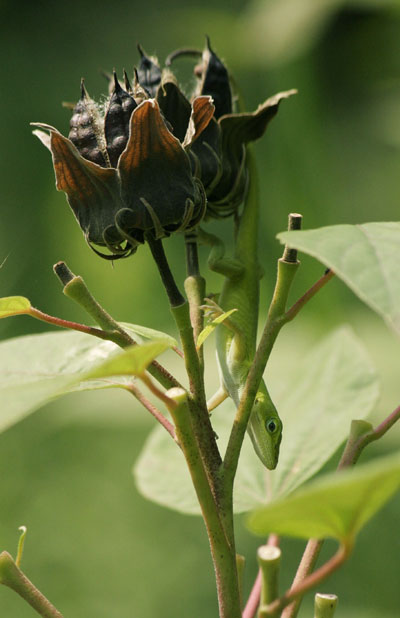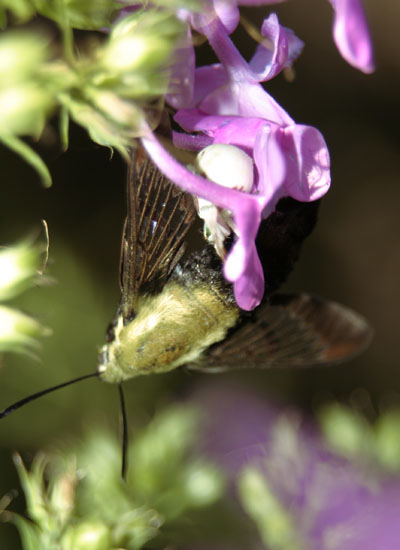I’m quick to tell anyone who wants to listen that the key to decent photography is composition. Technical proficiency certainly helps, but no one ever looks at a photo and says, “Wow, what a great use of exposure!” It’s what is in the photo that counts, and this can actually excuse some technical faults.
 But when the question is finding good nature and wildlife subjects to photograph, the key is to observe. And this doesn’t mean simply looking carefully around you, nor only at what makes a good image. It also includes noting and interpreting behavior, such as seeing signs that wildlife might use this area at other times, or knowing that the bird call you’re hearing is an alarm call in response to some threat – maybe you, in which case other wildlife in the area may now be alerted to your presence; or maybe something else, indicating that you may have an opportunity to catch the sudden appearance of a hawk or fox. It can also mean knowing what type of animal favors the particular habitat that you’re within, so you know what you’re even looking for. This can take a bit of practice, mostly to attune yourself to the sights and sounds that we rarely pay attention to, but it will almost certainly pay off.
But when the question is finding good nature and wildlife subjects to photograph, the key is to observe. And this doesn’t mean simply looking carefully around you, nor only at what makes a good image. It also includes noting and interpreting behavior, such as seeing signs that wildlife might use this area at other times, or knowing that the bird call you’re hearing is an alarm call in response to some threat – maybe you, in which case other wildlife in the area may now be alerted to your presence; or maybe something else, indicating that you may have an opportunity to catch the sudden appearance of a hawk or fox. It can also mean knowing what type of animal favors the particular habitat that you’re within, so you know what you’re even looking for. This can take a bit of practice, mostly to attune yourself to the sights and sounds that we rarely pay attention to, but it will almost certainly pay off.
This recent post is a good example, as is this much older one. And so is the photo at left. Busy looking for insect subjects, I would have missed this well-camouflaged green anole (Anolis carolinensis) if it hadn’t made an incautious move and attracted my attention. Both peripheral vision and the very quiet rustle changed my focus, allowing me to get several poses as it alternated between staying motionless and darting to a safer spot. And as I talked about here, a small shift in my own position caused the paler, brightly-lit leaves in the background to fall behind its head, providing a significant amount of contrast to highlight the lizard’s presence in the frame.
I make a point about macro (closeup) work: you can always find a subject, and usually it takes nothing more than sitting on the ground and paying attention. So much goes on around us at a level we don’t see unless we try, but it’s only through habit that we tune out other levels of activity. And it also applies to other forms of wildlife too. Animals are usually very symmetrical in shape, far more so than foliage and rocks, so being aware of patterns can help you spot critters quickly. Simply taking the time to try this can work well by itself, too. Remaining still and quiet means you don’t alert anything else to your presence, and it may feel safe to venture out where you can see it. Find a nice spot, get comfortable, and wait. What might have initially appeared to be a quiet landscape will usually reveal itself to be a world of activity.
 At right, a peek at the critter that was hinted at. The strange position of the common clearwing, or hummingbird, moth (Hemaris thysbe) was indication of something amiss, since these are active moths and aren’t ever seen alighting on a surface during the day, much less hanging down from flowers. Leaning around the edge provided me an obscured view of the culprit, which appears to be a goldenrod crab spider (Misumena vatia) – that’s the bulbous white blob alongside the lavender flower’s petals, with a few legs just barely visible gripping the moth. Whether the spider captured the moth on its visit to the flower or not, I can’t say – it’s typical behavior for the spider, but the moths don’t generally get that close to the flower, so I suspect an ambush at night, when the moths probably hide under leaves for shelter. Either way, it’s an impressive catch for the spider – less so for me, since this was the only angle I could achieve.
At right, a peek at the critter that was hinted at. The strange position of the common clearwing, or hummingbird, moth (Hemaris thysbe) was indication of something amiss, since these are active moths and aren’t ever seen alighting on a surface during the day, much less hanging down from flowers. Leaning around the edge provided me an obscured view of the culprit, which appears to be a goldenrod crab spider (Misumena vatia) – that’s the bulbous white blob alongside the lavender flower’s petals, with a few legs just barely visible gripping the moth. Whether the spider captured the moth on its visit to the flower or not, I can’t say – it’s typical behavior for the spider, but the moths don’t generally get that close to the flower, so I suspect an ambush at night, when the moths probably hide under leaves for shelter. Either way, it’s an impressive catch for the spider – less so for me, since this was the only angle I could achieve.
A decent knowledge of habits, calls, and habitats certainly takes time, though it can help a lot. Most of my own knowledge, however, came from the interest (meaning reading) and the time I’ve spent observing. So as spring approaches and while we’re in National Wildlife Week, get out there! It’s also a great way to forget about the petty human influences with which we concern ourselves too damn much.




















































You…are…my…hero!!! I cant believe something like this exists on the net! Its so accurate, so honest, and more than which you dont sound like an idiot! Lastly, a person who knows the best way to talk about a subject with out sounding like a kid who didnt get that bike he wanted for Christmas.
Thanks, Ms. Paquin! I’m flattered with the caliber of readers that I’m achieving now!
You probably should know that your attached URL was redirecting to some spam insurance site, so I took the liberty of changing it back to the site you obviously intended to be linked with.
Cheers!